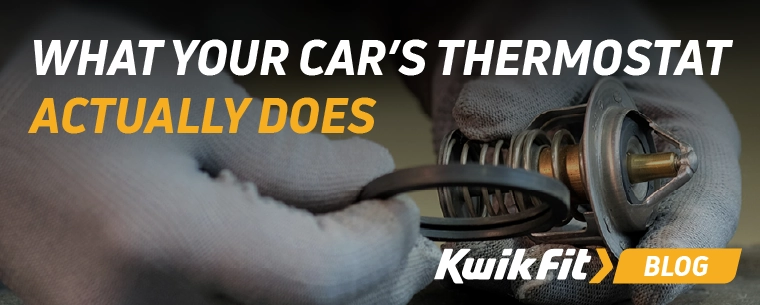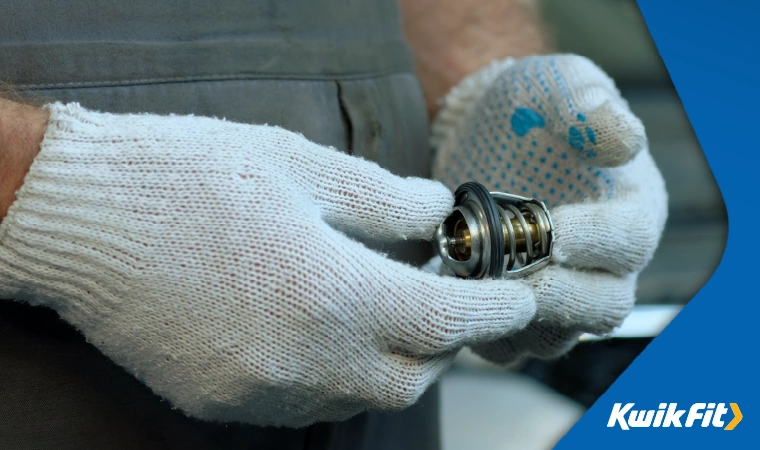What Your Car's Thermostat Actually Does
Jack Dreyer | Monday 23rd September 2024 8:00am

Beginning with the basics, a carís thermostat regulates the temperature of the carís engine. It does this by allowing the engine to warm up quickly but reacting to that heat by opening up and allowing coolant to flow through the radiator. A fully-working thermostat will make sure the engine stays at optimal temperature, whilst also providing a comfortable warmth within your carís cabin.
Usually, the thermostat is top-mounted and located close to the water pump on the cylinder head, and a hose from the top radiator feeds coolant through the thermostat into the engine. Whilst itís an often overlooked, and very small mechanical device, the thermostat is vital to the healthy running of a vehicle.
Read more on this blog to know more about what your carís thermostat does in more detail, how to test it, and when it needs to be replaced.
What does a carís thermostat do?
The primary function of a carís thermostat, much like any other thermostat such as those in buildings, is to control and regulate temperature. In a carís case, this is the temperature of the engine, which can often be prone to overheating.
By regulating the flow of coolant to the air-cooled radiator, the thermostat, which utilises a wax pellet that expands or melts based on temperature and thus operates a rod controlling airflow, keeps the engine at an optimal temperature to stop it from overheating. A malfunctioning thermostat would fail to regulate a hot engine and could lead to the warping of the cylinder head which can cause a blown gasket.
When the temperature runs hot, the wax melts and influences the rod, creating more airflow. When the wax hardens and expands during colder temperatures, the flow of air is reduced. This very simple mechanism is absolutely vital to optimal engine life and quality.
How to check if a thermostat is faulty
Sometimes, thermostats and the components connected to them can malfunction due to wear and tear. There are a number of ways you can check to see if a problem is being caused by a decaying or broken thermostat. There are usually two ways a thermostat will function:
- The valve stays stuck in a closed position, therefore trapping the coolant in the engine.
- The valve remains open, allowing coolant to constantly circulate through the engine or radiator.
If you find that the temperature indicator stays consistently low after driving for a few miles, and the heater inside the car isnít emitting any heat, then the valve is likely stuck in an open position.
If, however, you find that the temperature indicator on the dashboard is rapidly increasing and flashes, then the engine is overheating which could mean that the valve is closed. However, there are many alternative reasons the engine could be overheating, so itís important to check for a multitude of faults and to take your car in for a vehicle safety check.
If you suspect that your thermostat is having a problem, here are some of the ways you can check for damage, wear or malfunction:
How to find your carís thermostat
Firstly, you will need to find the thermostat in your car. It is usually located close to the water pump on the cylinder head. One way to find it is by locating the hose attached to the engine and following it until you come to the housing which contains the thermostat. But, you should consult your carís manual for more information.
Start the car and run a test
Once youíve found the hose, itís worth checking for any immediate damage. Do a quick test by starting the car when the engine is cold, then touch the top radiator hose. Make sure to take care and avoid the radiator fan.
If the thermostat is working as it should, then the hose will remain cool for around a minute to two minutes before quickly warming up. However, if the hose immediately starts to get hot when you start the engine, then thatís a sign the valve is stuck open.
Likewise, if the hose remains cool and doesnít heat up, then the valve is stuck closed.
You can also check the hose for any potential leaks, bulges or wear, in which case, the problem may be fixed by simply replacing the hose. The hose, or pipe, can become damaged through vibrations in the car, or if it runs up against other components. A way to check if the hose is potentially leaking is to check the level of fluid in the expansion tank, which should be between a H and L mark on the side. Make sure to do this when the carís cooling system has cooled down. If the fluid is unusually low after running the car, it may be that the hose/pipe is leaking.

How to replace a carís thermostat
You will need a new thermostat before you start, and this will have to fit your carís model, as they are unique to each car. Installing an incorrect or ill-fitting thermostat can cause irreparable damage to your vehicle. If youíre unsure, check our services and we can help you.
What you will need
You will need to be prepared before undertaking this task, so make sure to have the following items ready:
- Drip tray
- Socket set and spanner
- Flathead screwdriver
- Non-adhesive sealant
- An old rag
- A nail brush
- Fresh coolant to top up the radiator.
Step-by-step instructions to replace the thermostat
Firstly, you will want to prepare the area, and make sure you have your drip tray under the engine, this is to avoid coolant spilling over your floor. Next, simply follow the steps below:
- Take your screwdriver gently loosen the clamp from the top radiator hose.
- Ease the hose off the housing which contains the thermostat.
- Unscrew the nuts attaching the housing to the engine with a socket spanner.
- Ease off the housing from the engine.
- Simply remove the thermostat and gasket.
- Use a rag and clean the area where the thermostat was - remove any debris.
- Once the surface is smooth and clean, insert the new thermostat.
- Make sure to replace the housing by locking it back into place, rescrewing the nuts and tightening the clamp on the top radiator hose.
- Once youíre done, top up the coolant and test.
Trust in the experts
It can be difficult to find the issue in the first place, but ó even if you know that the thermostat or piping is broken ó finding the right thermostat and fixing it yourself can be tricky too. Putting in the wrong thermostat or not securing it properly can cause terrible damage to your car, so itís always best to take it into your nearest Kwik Fit centre as soon as possible.
If you suspect that your thermostat isnít working, or your engine is overheating for other reasons, why not bring your car in for a check? If youíve not had your engine checked for a while, then come on in for a free vehicle health check today.
Any facts, figures and prices shown in our blog articles are correct at time of publication.
Featured Articles
The 5 Most Scenic Roads in Europe to Drive
Thursday 2nd May 2024
For those who love exploring by car, Europe provides some truly breathtaking driving routes that showcase its stunning scenery. Find out 5 of our favourites.
Fun & Games - How to Use Summer Journeys for Family Bonding
Friday 4th August 2023
Kwik Fit launches games guide to help families play together on summer car journeys.
Safe Summer Driving Tips You Should Know
Monday 8th August 2022
With the summer holidays beginning, you may be planning on using your car often. However, before setting off in your car, follow these five useful tips for safer and more comfortable summer driving.







